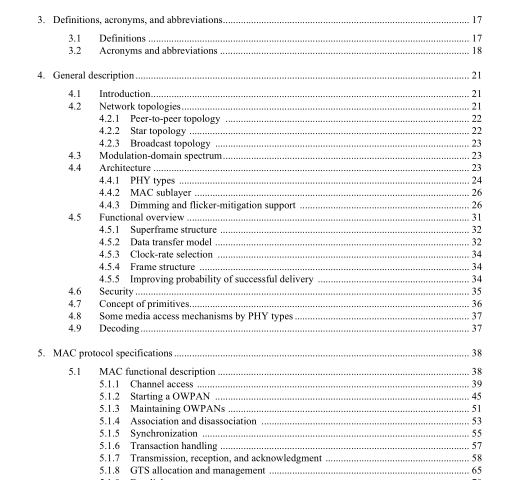IEEE 802.15.7-2018 pdf download.IEEE Standard for Local and metropolitan area networks— Part 15.7: Short-Range Optical Wireless Communications
4. General description
4.1 Introduction
In optical wireless communications (OWC), data is transmitted by intensity modulating optical sources, such as light-emitting diodes (LEDs) and laser diodes (LDs), faster than the persistence of the human eye. OWC merges lighting and data communications in applications such as area lighting, signboards, streetlights, vehicles, traffic signals, status indicators, displays, LED panel, and digital signage. This standard describes the use of OWC for optical wireless personal area networks (OWPANs) and covers topics such as network topologies, addressing, collision avoidance, acknowledgment, performance quality indication, dimming support, visibility support, colored status indication, and color stabilization.
Some of the characteristics found in this standard are as follows:
a) Star, peer-to-peer, or broadcast operation
b) 16-bit short or 64-bit extended addresses
c) Scheduled or slotted random access with collision avoidance transmission
d) Fully acknowledged protocol for transfer reliability
e) Wavelength quality indication
f) Dimming support
g) Visibility support
h) Color function support
i) Color stabilization support
4.2 Network topologies
As shown in Table 1, three classes of devices are considered for OWC: infrastructure, mobile, and vehicle.
This standard for OWPAN maps the intended applications to three topologies: peer-to-peer, star, and broadcast. See Figure 1.
In the star topology, the communication is established between devices and a single central controller, called the coordinator. In the peer-to-peer topology, one of the two devices in an association takes on the role of the coordinator.
Each device or coordinator has a unique 64-bit address. When a device associates with a coordinator node it is allowed to be allocated a short 16-bit address. Either address is allowed to be used for communication within the OWPAN managed by the coordinator.
The coordinator may often be mains powered, while the devices will often be battery powered. Each independent OWPAN has an identifier, as defined in 5.2.1.3 and 5.2.1.5. This OWPAN identifier allows communication between devices within a network using short addresses. The mechanism by which OWPAN identifiers are chosen is outside the scope of this standard. The network formation is performed by the higher layer, which is not part of this standard.
Apart from the peer-to-peer and star topologies, devices compliant to this standard are also allowed to operate in a broadcast-only topology without being part of a network, i.e., without being associated to any device or having any devices associated to them. A brief overview on how each supported topology may be formed is provided in 4.2.1, 4.2.2, and 4.2.3. In case illumination function is required, visibility support is also provided in the absence of communication or in the idle or receive modes of operation. The purpose of this mode is to maintain illumination and mitigate flicker.
4.2.1 Peer-to-peer topology
The basic structure of a peer-to-peer topology is illustrated in Figure 1. In a peer-to-peer topology, each device is capable of communicating with any other device within its coverage area. In a peer-to-peer topology, one of the peers acts as a coordinator. One peer defaults as the coordinator, for instance, by virtue of being the first device to communicate on the channel.
4.2.2 Star topology
The basic structure of a star topology is illustrated in Figure 1. All star networks operate independently from all other star networks currently in operation. This is achieved by choosing a OWPAN identifier that is not currently used by any other network within the coverage area. Once the OWPAN identifier is chosen, the coordinator allows other devices to join its network. The higher layer is allowed to use the procedures described in 5.1.2 and 5.1.4 to form a star network.IEEE 802.15.7 pdf download.IEEE 802.15.7-2018 pdf download
IEEE 802.15.7-2018 pdf download

Leave a Reply